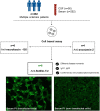Antibodies against the flotillin-1/2 complex in patients with multiple sclerosis
- PMID: 37091585
- PMCID: PMC10116574
- DOI: 10.1093/braincomms/fcad109
Antibodies against the flotillin-1/2 complex in patients with multiple sclerosis
Abstract
Multiple sclerosis is a tissue-specific autoimmune disease of the central nervous system in which the antigen(s) remains elusive. Antibodies targeting the flotillin-1/2 complex have been described in 1-2% of the patients in a recent study. Other candidate antigens as anoctamin-2 or neurofascin-155 have been previously described in multiple sclerosis patients, although their clinical relevance remains uncertain. Our study aims to analyse the frequency and clinical relevance of antibodies against neurofascin-155, anoctamin-2 and flotillin-1/2 complex in multiple sclerosis. Serum (n = 252) and CSF (n = 50) samples from 282 multiple sclerosis patients were included in the study. The control group was composed of 260 serum samples (71 healthy donors and 189 with other neuroinflammatory disorders). Anti-flotillin-1/2, anti-anoctamin-2 and anti-neurofascin-155 antibodies were tested by cell-based assays using transfected cells. We identified six multiple sclerosis patients with antibodies against the flotillin-1/2 complex (2.1%) and one multiple sclerosis patient with antibodies against anoctamin-2 (0.35%). All multiple sclerosis patients were negative for anti-neurofascin-155 antibodies. Three of the anti-flotillin-1/2 positive patients showed anti-flotillin-1/2 positivity in other serum samples extracted at different moments of their disease. Immunoglobulin G subclasses of anti-flotillin-1/2 antibodies were predominantly one and three. We confirm that antibodies targeting the flotillin-1/2 complex are present in a subgroup of patients with multiple sclerosis. Further studies are needed to understand the clinical and pathological relevance of anti-flotillin-1/2 autoantibodies in multiple sclerosis.
Keywords: antigens; autoantibodies; multiple sclerosis.
© The Author(s) 2023. Published by Oxford University Press on behalf of the Guarantors of Brain.
Conflict of interest statement
L.Q. received research grants from Instituto de Salud Carlos III—Ministry of Economy and Innovation (Spain), CIBERER, Fundació La Marató, GBS-CIDP Foundation International, UCB and Grifols, received speaker or expert testimony honoraria from CSL Behring, Novartis, Sanofi-Genzyme, Merck, Annexon, Alnylam, Biogen, Janssen, Lundbeck, ArgenX, UCB, LFB, Octapharma and Roche, serves at Clinical Trial Steering Committee for Sanofi-Genzyme and Roche and is Principal Investigator for UCB’s CIDP01 trial.
Figures





References
-
- Reich D. Multiple sclerosis. Nejm. 2017;176(3):139–148.
-
- Gastaldi M, Zardini E, Leante R, et al. . Cerebrospinal fluid analysis and the determination of oligoclonal bands. Neurol Sci. 2017;38:217–224. - PubMed
-
- D’Ambrosio A, Pontecorvo S, Colasanti T, et al. . Peripheral blood biomarkers in multiple sclerosis [internet]. Autoimmun Rev. 2015;14(12):1097–1110. - PubMed
-
- Bjornevik K, Cortese M, Healy BC, et al. . Longitudinal analysis reveals high prevalence of Epstein–Barr virus associated with multiple sclerosis. Science (80-). 2022;375(6578):296–301. - PubMed
